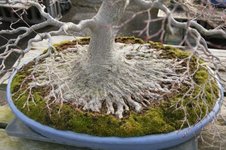Bonsai Tree
Seedling
- Messages
- 18
- Reaction score
- 12
Hello. I've been growing "pre" bonsai trees for a few years now and have had a question on my mind which I just can't seem to find an answer for.
If you're continually repotting and pruning the roots of the tree to make a flat base, won't this inevitably form a "pancake" root base? I assume that all of the roots will eventually fuse together and for that pancake nebari which I don't find appealing.
How can this be avoided if it is an issue? I have several trees that I've been growing in pond baskets, and when it's time to repot and prune those roots, I'm rethinking if I should trim the roots back to thwir flat base like I was planning. One of my trees is an air-layered crabapple, which already has nice radial roots and a flat base.
Can anyone help me understand this?
If you're continually repotting and pruning the roots of the tree to make a flat base, won't this inevitably form a "pancake" root base? I assume that all of the roots will eventually fuse together and for that pancake nebari which I don't find appealing.
How can this be avoided if it is an issue? I have several trees that I've been growing in pond baskets, and when it's time to repot and prune those roots, I'm rethinking if I should trim the roots back to thwir flat base like I was planning. One of my trees is an air-layered crabapple, which already has nice radial roots and a flat base.
Can anyone help me understand this?




